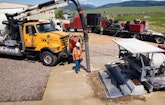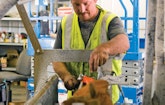Interested in Waterblasting?
Get Waterblasting articles, news and videos right in your inbox! Sign up now.
Waterblasting + Get AlertsAfter working in oil field piping construction for several years, and in waterblasting using high-pressure equipment since 2005, Dustin Prevost found the industry he felt was ripe for new technology and a place to develop some of his own ideas on quality service.
Prevost had “cut a lot of concrete,” in his career, and he chose that as the specialty for his business, Premium Hydro Solutions in Alpena, Mich. His plan was to excel in removal of concrete using robotic waterblasting and to work as a subcontractor throughout the United States.
Prevost operates with four technicians and an additional assistant – a robotic concrete cutter he designed to use with equipment from NLB Corp. In a very short span of two years, his company has had contracts in Michigan, Idaho, Montana and Indiana, as well as one job in Canada, where a crew removed concrete during a maintenance shutdown at a steel plant.
Other projects have included removal of concrete on bridges and overflow dams and in parking garages. Prevost says he is always looking for other opportunities. More than 60 percent of the work has been on government projects, and the company is enjoying significant repeat business with contractors and clients.
Prevost believed from the start that there was a better and safer way to remove concrete by using and improving on current technology. “I wanted to drive to improve the industry in my own business,” he says. “I had ideas to bring to the table.”
Road to innovation
When Premium Hydro Solutions leaves headquarters in Alpena or a major job, all equipment is transported on two Peterbilt rigs, each carrying two NLB model 20405D high-pressure pumps (20,000 psi/30 gpm), and one robot concrete cutter with NLB nozzles and hoses. Each rig makes up a complete self-contained waterjetting system.
Two pumps are needed to get the right configuration to cut the concrete. With both rigs on a project, the company can work in two areas at once. Two technicians operate a system, one stationed with the machine to make sure all is going smoothly and to run the robot’s computer, and the other at the pumps to observe the gauges and to check to see if the equipment is cutting to the right depth.
The pumps remain on the rig, and the hose runs from there to the robot, which moves the nozzle back and forth. The length of the hose from the pump to the cutter can run up to 500 feet, although 200 feet of hose is typical.
The robot can be programmed for the area and depth of concrete to be removed. Once the robot is positioned, the equipment is turned on and the movement of the cutter is actuated. The company mainly cuts concrete from flat surfaces.
The robot Prevost designed is 8 feet wide and 10.5 feet long. While it usually cuts concrete 1.5 to 4 inches deep, the cutter can go up to 14 inches and even deeper for projects such as coring or specialty jobs.
Design challenge
Prevost designed the computer system and the robotic cutter as a robust way to remove concrete and to deal with rough surfaces. The goal was to develop a process that would give a controlled cut, and finding the solution took considerable research and networking with experts.
The NLB pumps are suited for the work because they have relatively few moving parts and offer high operating efficiency, Prevost observes. The process can be 20 to 30 times faster than conventional methods, depending on the depth of the cut, he says.
The important thing for a smooth operation is to have the proper equipment, proper fittings, and basic safety gear. Prevost says it sometimes takes a while for contractors to get used to the procedure.
Learning about projects requires research, and Prevost prefers to do subcontract work with a company that has a track record. On specialty jobs beyond basic concrete removal, he checks in advance to see what the project involves. The goal is to provide whatever the contractor customer needs. Much of their work is done at night or on weekends – sometimes on a 24-hour schedule.
“We always do our work in a timely fashion, and we have an open relationship with the prime contractor,” says Prevost. “These projects can be unique.” The most stressful jobs are those that are large and on a tight timeline.
Lots of maintenance
On the Canadian steel plant shutdown job, crews worked in several sections, including an area where train tracks had been taken up and Premium Hydro removed 2.5-inch-thick concrete. The prime contractor’s crew came behind, cleaning up and overlaying the surface with new concrete. The railroad tracks were then put back in place. The crews worked seven days around the clock – the concrete removal alone took 2.5 days and was done ahead of schedule.
When not busy on jobs, Premium Hydro employees are at the 4,000-square-foot shop in Alpena working on the equipment, which requires substantial maintenance. “This equipment is working in a rough environment – concrete and water – and we basically do a lot of maintenance so we can be more effective on the job,” says Prevost. “This involves changing oil, greasing, and checking bearings. You have to stay on top of that.”
Prevost is involved in any design or fabrication of equipment that will provide better service on a job. He is now working on the concept of a robot specifically for concrete removal on walls and overhead.
Up to the task
Prevost’s four technicians came from construction backgrounds, but they did not have high-pressure waterblasting experience. He trained them to operate the machinery and to work safely. Job applicants are asked to study articles in trade journals, and NLB has provided training on its equipment.
Trained and skilled personnel are always present on work sites. Workers wear traditional safety gear: hardhats, gloves, reflective vests, glasses, safety steel-toed boots, and other protective gear required for waterblasting.
The Premium Hydro system does no damage to reinforced steel. In fact, Prevost says, the steel is actually cleaned in the process. For each project, Premium Hydro provides support service as needed. Sometimes, a crew must remove a membrane or epoxy before cutting concrete. Debris removal is usually handled by the prime contractor, but when Premium Hydro is asked to handle that side, the firm partners with Aero Power-Vac from Missoula, Mont. to vacuum the concrete and handle disposal.
Challenges on a job site typically involve surface cracks that develop over time from heavy traffic and the elements. “When the strength of the concrete is hard, it can slow us down, but that is not a huge problem,” says Prevost. “Hydro can cut it.”
While on the job site, Premium Hydro Solutions provides expenses, pays a per diem. The firm also provides leaves for employees on long-term projects. For example, if a job runs several weeks, the men get a break to return home after a month. Prevost is on job sites at least 50 percent of the time. Otherwise he is back at his Michigan office, catching up on paper work and looking for other projects. He has complete confidence in his employees.
An inventive mind
Designing his own equipment comes naturally for Prevost. “I basically eat, sleep, and breathe this technology,” he says. “I’m always thinking of a different way to help contractors out, so they can get the job done faster and more efficiently. I will design whatever needs to be done. It depends on the needs of the customer. If we see something that can be improved, I go home to the shop. I will continue to do that kind of thing.”










